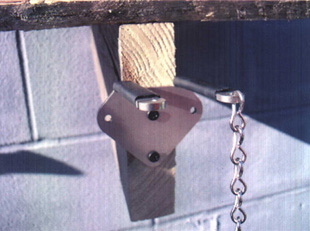- Standard Number:
OSHA requirements are set by statute, standards and regulations. Our interpretation letters explain these requirements and how they apply to particular circumstances, but they cannot create additional employer obligations. This letter constitutes OSHA's interpretation of the requirements discussed. Note that our enforcement guidance may be affected by changes to OSHA rules. Also, from time to time we update our guidance in response to new information. To keep apprised of such developments, you can consult OSHA's website at https://www.osha.gov.
February 26, 2004
Mr. Robert Stanley
KPS, Inc.
11750 Diode Court
Louisville, KY 40299
Re: Extension ladder; ladder securing device; §1926.1053(b)(1).
Dear Mr. Stanley:
This is in response to your December 29, 2003, letter to the Occupational Safety and Health Administration (OSHA) regarding OSHA's construction standards. We have paraphrased your question as follows:
Question: KPS Inc.'s New Construction Ladder Retainer ("Retainer") is designed to secure the upper part of a portable ladder to the structure the ladder is leaned against. The Retainer is a small stainless steel assembly that is attached to the rafter end or gutter board and then to the ladder upright to keep a ladder from moving side-to-side while the user is on the ladder; see pictures below:


What OSHA construction standards apply to the use of this device, and does it meet those requirements?
Answer
OSHA is generally precluded from approving or endorsing specific products. The variable working conditions at job sites and possible alteration or misapplication of an otherwise safe piece of equipment could easily create a hazardous condition beyond the control of the equipment manufacturer. However, where appropriate, we try to give some guidance to help employers assess whether products are appropriate to use in light of OSHA requirements.
Section 1926.1053(b)(1) states:
(b) Use. The following requirements apply to the use of all ladders, including job-made ladders, except as otherwise indicated:(1) When portable ladders are used for access to an upper landing surface, the ladder side rails shall extend at least 3 feet (.9 m) above the upper landing surface to which the ladder is used to gain access; or, when such an extension is not possible because of the ladder's length, then the ladder shall be secured at its top to a rigid support that will not deflect, and a grasping device, such as a grabrail, shall be provided to assist employees in mounting and dismounting the ladder. In no case shall the extension be such that ladder deflection under a load would, by itself, cause the ladder to slip off its support. [Emphasis added.]
Under this standard, where the ladder's side rails do not extend 3 feet above the upper landing surface, in addition to providing a grasping device, the ladder must be secured "at its top to a rigid support that will not deflect." Assuming that the screws used to affix the Retainer to the building, and the Retainer itself, have sufficient strength, 1 its use to secure the top of a portable ladder to a part of the structure (such as a rafter end or gutter board) would likely be sufficient to comply with this securing requirement.
If you need additional information, please contact us by fax (202-693-1689) at: U.S. Department of Labor, OSHA, Office of Construction Standards and Guidance. You can also contact us by mail at U.S. Department of Labor, OSHA, Office of Construction Standards and Guidance, Room N3468, 200 Constitution Avenue, N.W., Washington, D.C. 20210, although there will be a delay in our receiving correspondence by mail.
Sincerely,
Russell B. Swanson, Director
Directorate of Construction
1Note that we are not in a position to evaluate, from an engineering standpoint, the strength of the screws or the device. [back to text]

